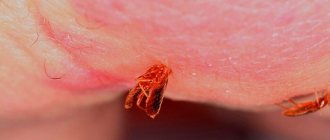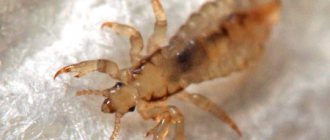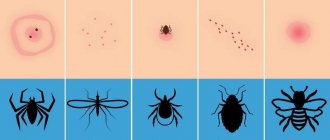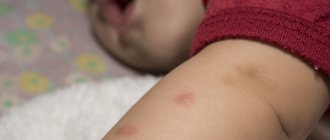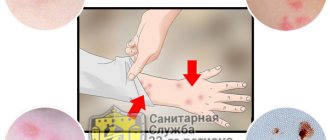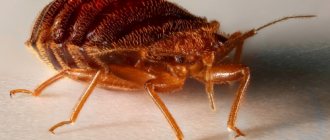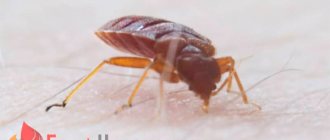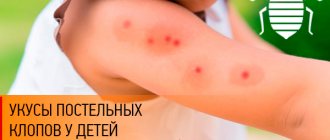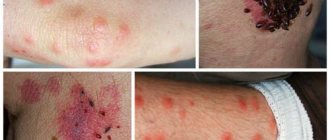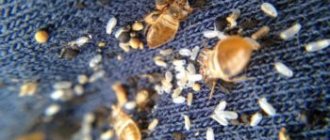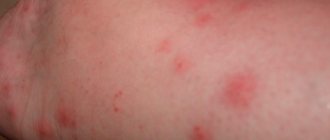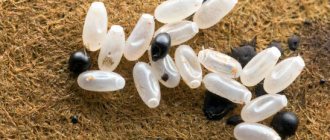Bedbug bites can be a year-round nightmare. In this article you will learn how to distinguish bedbug bites from mosquito and flea bites and why a person does not feel anything at the time of the bite.
Let’s answer the popular question: “Is it true that even two people sleeping in the same bed can have completely different reactions to these bites?” We will also tell you how to relieve yourself of itching after a bite and prevent new ones from appearing. Forewarned - forearmed! Let's start!
Contents:
- The most important facts about bed bug bites
- Bedbug bites symptoms and differences
- What places do bedbugs like to bite?
- How do bedbugs bite?
- Allergy to bedbug bites
- How to treat bedbug bites?
The most important facts about bed bug bites
Do bedbug bites itch?
During a bite - no. You don't feel anything. You don't feel pain when you bite because the bedbugs inject a temporary analgesic under your skin to help keep you from feeling pain.
How long do bedbugs bite?
From 3 to 10 minutes - this is how long one full feeding lasts. It starts with the appearance of medium to large spots (swollen or flat) on any part of the human body (the most common places include the face, neck, arms and hands). Also, with the appearance of spots, itching and redness appear.
Bites from house bugs are often confused with bites from other insects. Sometimes they are mistaken for infectious rashes on the human body or even for injuries. And the true reason is determined in the very last place. There are cases when dermatologists confused bedbug bites on the body with chicken pox or an allergic reaction. Although for experienced entomologists, recognizing bites after bedbugs is not particularly difficult, since they have a distinct, specific appearance. It will not be superfluous to know the characteristics of bites for ordinary residents of apartments or private houses. The faster you recognize the presence of parasites in the room, the more effective the fight against these insects will be.
Parasites cannot tolerate strong odors. They confuse the insects. The bug cannot detect a person, and being in such a room becomes unbearable.
Do bedbugs bite through clothes?
To understand whether a house bug can bite your clothes, you just need to know how its oral system works. The parasite makes a puncture in human skin with its proboscis, which is only 0.7 mm long.
Its small size prevents it from reaching the human epidermis through clothing. In addition, the fabric has a denser structure than human skin, and the lack of elasticity of the proboscis prevents insects from piercing the material.
While wearing clothes, the insect tries to crawl under it or run away in search of shelter.
What do bedbug bites look like on adults?
Externally, bedbug bites on the skin resemble mosquito bites, but they are more painful and have clear edges.
If an adult is bitten by a bug, then a small, round, red swelling with a pronounced bump in the middle will appear on his body.
Multiplicity and grouping are the distinctive features that characterize bedbug bites on human skin. This is due to the fact that while feeding, each individual makes not one, but five or seven bites on the human body, sucking blood from each puncture. If the bites are located on the same line, then you can confidently conclude that you have been bitten by bedbugs. This arrangement is typical only for these parasites. As a rule, the distance between each subsequent bite made by one individual is from three to four centimeters. When studying what bedbug bites look like on the human body, remember that insects do not feed in an organized manner, but collectively. In other words, a large number of bites may appear on a person’s body in the morning, located close to each other. But in each group specific tracks will be clearly visible.
Before going to bed, apply a few drops of lavender, chamomile, lemon balm or St. John's wort essential oil to your body. You can add two or three drops to the cream.
It is worth noting that experts identify several dozen types of bed bugs. But individuals of each species bite people in almost the same way. All bedbug bites on the human body look the same, and the differences between them can only be seen with a microscope.
Have you been bitten by mosquitoes or just got pimples?
The material is, naturally, serious, but still you will remember how old you are. The likelihood that redness on the skin is ordinary acne is extremely high. Here it is worth highlighting several characteristic signs.
If the spot is somewhat swollen, and when pressing on it there is a painful sensation, then you have to deal with an ordinary pimple. Also, their distinctive feature is a white accumulation of pus in the middle.
However, the presence of acne is not always associated with puberty. It's enough to sweat, walk down the street in the wind, and pimples may form the next day. Their placement on the body is not subject to special laws, and in most cases they can be instantly recognized.
Well, behind are all those who bite in bed at night except bedbugs. Go ahead!
What do bedbug bites look like in children?
Children are a special risk group. In apartments or private houses where house bugs live, small children will be the first to be attacked. This is due to the fact that babies have more delicate and thin skin, to which blood vessels are located very close. At the same time, body odor in children is not as pronounced as in adults. It does not cover the smell of blood, which attracts bedbugs.
Externally, bedbug bites in children look similar to the bites of adults. But, if for men this situation is not a problem and a bug bite can become almost unnoticeable by the morning, then for children the situation is different. Children's skin is very sensitive, and a domestic bug bite will leave a mark for a long time. Moreover, the areola of redness near the bite itself will be bright red and large. And if you also take into account that the place where the bugs bit is itchy, then small children will definitely aggravate the situation. Therefore, adults should use a special anti-bedbug ointment or other medications at the first suspicion.
A few words about fleas
Earth fleas can inadvertently be introduced into an apartment. They enter residential premises from entrances or basements. The risk increases if you have a pet, say a cat or dog.
The harmful activities of fleas can be easily distinguished from the way bedbugs bite. Firstly, the spots themselves are smaller. They do not have blood spots in the center. Secondly, the bites almost never swell. Thirdly, they feed in the waist, feet, and armpits.
It is impossible to write off age-related characteristics in the process of analyzing red spots.
Bedbug bites symptoms and differences
In most cases, bedbugs attack at night. And only in the morning a person notices inflamed areas on the body.
If you have bed bugs, bed bugs, symptoms and other features should be carefully studied. To do this, we highlight important key points that allow a person to determine that a mark on the skin is the result of a bedbug bite:
- severe itching and burning;
- pronounced tubercle;
- there is a red areola around the tubercle;
- number of bites from three to five in one area;
- bites are located in a straight line;
If you find similar features in bites, inspect the bed. Drops of blood or black spots may remain on the laundry.
Bed bugs that have drunk enough blood can be easily crushed by hand while sleeping. Their remains are visible on the bed.
Bedbug bites differ from flea or mosquito bites in their multiplicity. They are also more red and very painful. Unlike ticks, bedbugs, on the contrary, leave soft and small punctures. In this case, during a bite, the bug plunges into the skin almost with its head. They also differ from allergies. An experienced dermatologist will notice with the naked eye a small puncture from a bite on the red bump.
Can they live in clothes?
Bloodsuckers have a good sense of smell and are attracted to the smell of the human body. They easily find people's everyday clothes where they build their nests. They prefer things with numerous pockets, folds and seams.
Bedbugs can live in human clothing.
Which one do they like?
Parasites choose wardrobe items that are in direct contact with the human body: pajamas, shirts, underwear and other home clothes. In this case, the material from which it is made matters. For example, pests do not like fleecy products because they cannot cling to them with their paws, which deprives them of the ability to move. They do not distinguish other fabrics.
What places do bedbugs like to bite?
The bug mainly bites at night and in those places where the skin is thinnest and the blood vessels are located close to the surface. Parasites are primarily attracted to exposed areas of skin, and only then do they get under clothing and continue to suck blood. Most often, vinegar for bedbugs can be found:
- on the back and shoulders,
- on the legs and arms,
- on the neck and back of the head.
Quite rarely, marks appear on a person’s face or stomach.
I had bedbugs in my apartment that were discovered after the first bites. Before going to bed, I lit an aromatic lamp with the scent of lavender, put a few drops of oil on the night lamp and put lavender sprigs under the bed. The insects stopped biting.
Who do parasites bite?
When attacking people, the pest can be selective. If two people sleep in a bed, in the morning only one person may notice bites on the body.
Who do pests prefer to bite:
- If there is a choice, the insect prefers the victim with the thinnest skin structure: it is easier to bite through, and the taste of blood is better felt through the thin skin.
- Based on the previous fact, it can be argued that children are the first to be at risk, then women. Less commonly, parasites bite men.
- As for the preferred blood type, in the case of bedbugs it is the first.
- Insects are interested in searching for open areas of the body, for this reason they give preference to the most undressed victim.
Video
Bed bugs in your home
How do bedbugs bite?
The parasite's mouthparts resemble a proboscis. With its help, the insect pierces the human skin and sucks out blood. Blood is the food for these insects. The process is quite simple. The parasite chooses a suitable place for it and bites through the human skin. After this, he sucks some blood from the resulting hole and moves further along the body. At a distance of three or five centimeters, it again bites through the skin and drinks blood.
At one time, an insect can make five or seven bites and only then get enough.
But do not forget that only one bug makes 2-3 bites per night! How many of these live in your bed?!
According to scientists, up to several thousand bedbugs can live in one bed. But this is not the limit: there is a real case when 150 thousand bedbugs were found in a single room, most of which lived in the bed! Therefore, if at least a tenth of this army of thousands is hungry, in the morning your body may be covered with multiple red itchy bites.
Bedbugs are not afraid of light and can bite even during the day.
Despite the fact that bedbugs only come out to feed at night (usually from 3 to 8 o’clock), in exceptional cases this can also happen during the day. This happens if the bedbugs are very hungry (so you understand what “very” means: bedbugs can live UP TO A YEAR without food!). What is force majeure for a bedbug? This is the absence of people nearby snoring peacefully at night. At risk: laundries, public transport, airports, offices and any other non-residential premises.
The following follows from this fact: bedbugs will not be afraid even of bright daylight or artificial light if they want to get their portion of blood. And they will want to!
Bedbugs bite all year round
Unlike other biting insects that have certain peaks of activity, bed bugs will live in your warm bed winter and summer unless you get rid of them.
Do bedbugs bite dogs?
Yes, they bite. Sometimes the most severe suffering from bedbug bites falls on dogs, and while in the house, bedbugs can feed on their blood for a long time before moving on to you. Why is this happening? It's simple: dogs, like cats, sleep most of the day - up to 18 hours! This allows bedbugs to drink blood without any problems, either at night or during the day.
Can bedbugs bite through clothing?
It's possible. Bed bugs pierce skin and suck blood using their proboscis, but it is not designed to pierce fabric, plastic or paper. If you sleep in pajamas, this may work to your advantage, but not for long - bedbugs run quickly and will still get to open areas of the body.
How dangerous are bedbug bites?
This is the question that most worries people who have been bitten by bedbugs. According to entomologists, up to 27 viruses of various diseases can be found in bedbugs, but it has been proven that they cannot transmit diseases through a bite.
This fact cannot but rejoice. Unlike the reactions of the nervous system to bites.
Scientists confirm that frequent bites may cause sleep disturbances, including insomnia, stress and irritability. It is believed that bedbug bites can cause constant crying in newborn babies. Also, in particularly severe cases, with significant blood loss, infants may develop anemia, and if the skin is particularly sensitive, any person may experience an allergic reaction.
Attention! Despite the fact that bedbugs are nocturnal insects, they are less afraid of light than of being hungry. They will come even if you turn on powerful spotlights in the room.
How long do the bites last?
Bedbugs need fresh portions of blood every 3-4 days, but if they have already managed to actively reproduce, then the bites will not have time to heal, because more and more new ones will be added to them. Since bites may not make themselves known immediately, you are unlikely to be able to pinpoint exactly what day you were bitten. As experts state, it can take up to 3-4 days for symptoms to appear, and in some cases up to 14.
Redness, itching, and swelling of the skin usually disappear within a few days. In more severe cases, for example, when a person has been bitten by hundreds of bedbugs, it will take longer - up to 3 weeks. If the bites do not go away, or you notice an increasing deterioration in your health, immediately consult a doctor - you may have an allergy, which should be treated under the supervision of a specialist.
Excessive paranoia
Suspicious people, without any real reason, often complain about biting bedbugs. By the way, not only they can irritate an area of skin, but also mosquitoes, fleas, and midges.
The mental aberration of people can be explained by:
- Stress at work. This problem is quite well known to many. It happens that the boss will be rude or the employees will set you up. This results in bad mood, loss of strength and paranoia.
- Allergies. Redness of the skin in some people occurs due to allergic reactions. An unpleasant itching also appears.
- Chickenpox or dermatological pathology. Industrialization keeps pace with urbanization - many unpleasant diseases appear. Mostly points on the body indicate chickenpox or another disease. If you find any, try to understand where the stains could have come from. In any case, do not be lazy to consult a doctor.
Allergy to bedbug bites
The saliva of young individuals is considered the most dangerous. The allergen, penetrating inside, quickly spreads throughout the body. An allergic reaction can be local or general, worsening the condition of the entire body.
Allergy to bedbugs differs from other reactions in the following manifestations:
- In case of allergies, the bite mark exceeds 1 centimeter in diameter.
- A rash appears.
- Bite marks last for more than a week.
- Severe itching appears.
In addition to visual signs, other symptoms indicate the appearance of an allergy:
- Nasal congestion or severe runny nose.
- Dizziness, severe headache.
- Weakness.
- Labored breathing.
In rare cases, anaphylactic shock or Quincke's edema may occur.
Habitats of bloodsuckers
In everyday life, bedbugs are called differently: bed bugs, sofa bugs, house bugs, furniture bugs, clothing bugs. These are all one type of insect. The name depends on where they are found.
Bedbugs live under carpets.
Blood-sucking parasites settle in close proximity to the main source of food - humans. They often make nests not far from his sleeping place: in bedside tables, cabinets, sofas, beds, under mattresses. Thanks to their flattened body, arthropods are able to penetrate into the smallest crevices. At the same time, they choose warm, dark and hard-to-reach places:
- behind ceiling panels;
- under baseboards, window sills;
- between books on shelves;
- behind paintings, wall clocks;
- under wallpaper, carpets.
In some cases, pests live in the housings of household appliances, behind heating radiators, inside sockets and switches.
How to find and signs of their presence
The first thing to think about infesting an apartment with bedbugs is when bite marks appear on the residents’ bodies. These are red spots with a black dot in the center (the puncture site) and are often accompanied by itching. If you find them, you should start searching for harmful insects.
Using a flashlight, they examine their favorite habitats. The bugs present there will scatter, because they cannot stand bright light.
More often in the nests you can see not the bloodsuckers themselves, but signs of their vital activity:
- discarded shells - scraps of shells after molting larvae that look like husks;
- excrement (feces) – small black balls with an unpleasant odor;
- empty egg shells - formations similar to small grains of rice, with a hole for the larvae to exit.
You may notice signs of bed bugs.
Sometimes brown stains remain on the bed linen. These are drops of blood that are formed when a sleeping person crushes saturated parasites.
If there are too many bedbugs, a specific smell appears in the room - the aroma of old cognac or soured raspberries. The residents themselves do not always feel it, but strangers immediately notice.
How to treat bedbug bites?
As a rule, bedbug bites go away on their own after a few days. Men tolerate them especially easily. As for children, in this case certain actions should be taken. For example, you can use a special ointment for bedbug bites.
Medicines or pharmaceutical products to treat bites
If you don’t want to use traditional recipes, you can buy medicine for bedbugs:
Star
The most accessible and harmless remedy. If you lubricate the bite site with balm several times a day, the inflammation and itching will go away within a few days.
Price: 83 rub.
Bepanten gel
Suitable for people of all ages. The drug relieves itching, swelling and inflammation.
Price: 673 rub.
Psilo balm
Works like Bepanten gel.
Price: 239 rub.
Comparative table of remedies for bedbug bites
| Product | Type of impact | Price |
| Star | Relieves itching and symptoms of bites | 83 RUR |
| Bepanten gel | Heals damaged skin | 673 RUR |
| Psilo balm | Heals damaged skin | 239 RUR |
| If you have a severe allergy, be sure to go to the doctor | comprehensive approach, competent treatment | Depends on honey. insurance |
Treatment of a severe allergic reaction
The question of what to apply to bedbug bites when a severe allergic reaction occurs deserves special attention. If you are allergic to bedbug bites, treatment should be prescribed by a doctor. The specialist will prescribe antihistamines. This may be a cream, ointment or tablets. Most of the prescribed drugs are hormonal drugs. Therefore, it is important to correctly determine the dosage and course of treatment. Self-medication in this case is unacceptable.
Folk or home remedies for treating bites
If you don’t know how to treat bedbug bites, pay attention to traditional medicine. There are several home remedies that can help you cope with bites and alleviate their consequences:
- Redness and itching will become less severe if you rinse the bite area under cold running water.
- A bath with the addition of a decoction of St. John's wort, calendula and chamomile will help relieve the inflammatory process.
- Use alcohol to disinfect the affected skin area.
- You can lubricate the bite site with aloe juice or apply pieces of ice to it.
- Laundry or tar soap, as well as soda, are good for bites.
Remember! Bed bugs get used to the unpleasant smell. The use of aromatic oils is a prevention of bites.
Folk remedies to relieve irritation
Folk remedies for relieving irritation from bites If there are no antihistamines in the house, you can try to relieve the itching using improvised means:
- a hot bath will steam the skin, speed up the movement of blood, due to which the poison will be distributed over a larger area, and relieve itching;
- moistened plantain leaf - the moisture on the attached leaf will cool the irritated areas, and the itching will subside slightly;
- a compress moistened with a concentrated soda solution soothes itching;
- cooling with ice reduces the local temperature of the inflamed skin, the itching subsides;
- lotions with decoctions of antiseptic herbs: chamomile, St. John's wort, plantain cool the bite site;
Consequences of bites for the body as a whole
It is impossible to predict the consequences. Each organism is individual, as is the reaction to a bite. It is worth noting that children of bedbugs cause the same harm to humans as adults. If bedbugs have left bites on the body, they must be disinfected. Otherwise, an infection may develop on the wound, which will lead to a severe deterioration in the general condition.
After bedbugs leave bites on a person’s body, itching and burning appear, causing irritability, insomnia and even depression. You must immediately relieve the itching and begin exterminating insects.
I've been sleeping on an air mattress for a couple of weeks now because of bedbugs.
I threw the sofa in the trash. An absolutely beautiful sofa that was only three years old. There was only one alternative - to remove all the upholstery and find the nests, but it was cheaper to throw it away.
If bedbugs remain in the apartment, they will happily set up a colony in the new sofa (and new sofas can come from the factory with their own bedbugs - this happens). Therefore, a strategic decision was made to buy an air mattress for a while. If parasites are still living in the house, they will almost certainly soon be found under the mattress. But so far they are not visible, and the bites have finally passed. After I threw out the couch, I only caught a couple of bugs in the first two days - perhaps they came from the couch itself while I was tearing it apart and tearfully kicking it to get it into the elevator.
The war lasted all of August and now seems over, but I am not relaxing. A control treatment is planned for the near future - the room will already be devoid of baseboards and linoleum, just to be sure. And only then will I decide to add a new sofa to the house. I wish you never to face this misfortune!
Bedbug bites in children
Above we described in detail what a bedbug bite looks like on the body of an adult. Parasites leave a similar mark on the bodies of young children. It is worth noting that insects bite small children more often than adults. This is due to the physiological characteristics of the child. Babies have more delicate skin and blood vessels are located closer to the skin.
Danger for children
The danger of bites for children is the high risk of an allergic reaction. The parasite's saliva contains a dangerous poison, which, when bitten, penetrates the child's skin and instantly spreads throughout the body. If the baby has a tendency to allergic reactions, then the consequences of the bite can be quite severe.
Another danger is the desire of children to scratch the bite. As a result, a wound forms on the baby’s body, on which other infectious diseases can develop.
Symptoms
After a domestic bug bite, redness appears on the child’s body, which is very itchy. In the middle of the red spot you can see a small bump. The number of bites ranges from three to five pieces. They are located in a straight line. Children become whiny, nervous and constantly scratch the bite sites.
Reviews from people
Ekaterina, 37 years old, St. Petersburg: “Two years ago, our family faced a problem: bedbugs infested our apartment. At first I noticed small red spots on my son’s back and assumed it was an allergy. Then she discovered bloody specks on the bed linen. Then they thought about bedbugs, turned the sofa over, and there were whole colonies there. To remove insects, they turned to specialists. Exposure to cold fog helped.”
Alexander, 45 years old, Novosibirsk: “When bedbugs lived in our house, it was terrible. It’s not clear where they came from, but we found unpleasant insects everywhere: in mattresses, clothes, under the sofa and baseboards. It took a long time to get rid of them, using various methods. I don’t know what product worked, but I’m glad there are no more bedbugs.”
Irina, 52 years old, Krasnodar: “I discovered these insects at home after visiting a neighbor. Perhaps she brought them on her clothes. I noticed red spots on my body in the morning, then itchy skin appeared. To kill bedbugs, I used both folk and store-bought remedies. However, the effect is temporary: they first disappear, then appear again.”
Source
How to protect yourself from bedbug bites?
There are many myths on the Internet about what remedies help protect against bedbug bites. Here are the two most common myths:
- Repellent sprays will protect you from bites. Not true. Repellents can help against the bites of mosquitoes, ticks, and some other insects, but the bugs didn’t care what you sprayed on yourself.
- Insecticidal "bedbug bombs" can kill insects and thereby prevent their bites. Not true: unfortunately, they also don’t work, because the smoke from the insecticide cannot get into those hidden places where bedbugs are buried. Moreover: having felt such a chemical attack, the bedbugs will hide even deeper into their crevices - and then it will become even more difficult to get rid of them!
To protect yourself from their bites, you need to use only products tested and approved by scientists. And don’t forget: you need to get rid of not only adults, but also larvae and even potential adult biter eggs.
But not everything is so simple: you cannot destroy bedbugs with any one method. Along with thorough cleaning, you need to comprehensively use other methods, for example, an electronic bedbug repeller .
Here are 3 main steps:
- use bedbug detectors to identify the presence of bedbugs in the house and even their routes.
- “dress” your mattress in a special mattress protector to cure an old mattress or protect a newly purchased one from bedbugs.
- purchase an effective anti-bedbug spray to treat infested areas in the house.
Remember: up to 150 thousand bedbugs can live in your bed! So don’t delay and start the fight right now!
Ways to combat bedbugs
If you decide to get rid of unwanted insects in the house yourself, it is recommended to use a combined method:
- treat the room with a chemical;
- wash clothes, linen and bedding at high temperatures;
- organize a protective barrier that will prevent the reappearance of blood-sucking parasites in the house.
Effective ways to combat bedbugs is to seek help from professional pest control services. To kill parasites, it is customary to use the hot and cold fog method. It involves spraying a chemical using a generator. The device supplies insecticide in the form of tiny particles. They hover in the air and gradually settle on all surfaces of the room - walls, floors, ceilings, interior items. The small diameter ensures the penetration of the toxic substance into all cracks, holes and hard-to-reach places in the apartment.
The hot and cold fog methods differ in the temperature of the chemical preparation. Preference is given to a heated insecticide if it does not damage interior items, wallpaper, or flooring. But in most residential areas, treatment is carried out using the cold fog method.
The professional pest control service “Dez Group” uses certified chemicals with a prolonged effect to kill bedbugs. The poisonous substance continues to have a detrimental effect on parasites for several days. This ensures the death of all individuals and larvae, including those that emerged from the egg after treatment at home.
How dangerous is a bloodsucker attack for a person?
Of course, bed bug bites do not pose a serious danger to humans. However, the physical discomfort they cause can lead to unpleasant consequences. For example, constant itching that gives no rest can deprive you of sleep and prevent you from relaxing, so a nervous breakdown due to constantly itching bites is quite common.
Some people (especially women) who are afraid of insects, upon noticing such “neighbors” in bed, can reach the point of panic and even hysteria.
Possible consequences
People with rougher skin tolerate bedbug bites much more easily. The small wounds left on their body only itch slightly, so the defects resolve quite quickly and painlessly. But people with sensitive and delicate skin constantly scratch the damage , leading small wounds to the appearance of complications and abscesses.
There is a small percentage of people who are so susceptible to the bites of these parasites that they develop an allergic reaction to any damage caused by the bed bug. For such patients, encountering parasites poses a serious danger (they are at risk of developing edema and suffocation). An advanced allergy can result in anaphylactic shock.
How many times does an insect usually bite?
During one feeding procedure, a bug can penetrate the skin 1–10 times. However, a single bite is very rare . Typically, parasites move in a straight line, leaving behind a string of identical defects. Damage in such a “path” is located at a short distance from each other. An adult requires large volumes of blood to be completely saturated, which is why one bite cannot do it all.
But nymph larvae are quite capable of biting through the skin only once. They don't need a lot of food yet, so they eat from one damage. Older larvae are more voracious and can make 2-3 bites in one feeding.
Only one larva can live on one bed, and its parents are always present nearby. So if you have a single damage, then it is most likely the mark of a mosquito or other insect, but not a bedbug.
Are insect bites dangerous?
There is no scientific evidence that bedbug bites cause serious harm to human health. It has not yet been established that bedbugs act as carriers of infections. Therefore, apart from an allergic reaction, parasite bites do not cause anything.
In the case where the puncture sites are constantly scratched, infection may penetrate through the damaged epidermis. Against this background, inflammatory lesions develop. Along with physical discomfort, psychological discomfort arises. The person stops sleeping peacefully and becomes nervous and irritable.
How should you prepare for the arrival of the health service?
General cleaning is not a prerequisite, but if you plan to do general cleaning, it is better to do it BEFORE treatment, not after. After treatment for 14 days, it is not recommended to carry out general cleaning, only cleaning of contact surfaces (places that you constantly touch with your hands).
- Children's things and toys must be isolated from open areas.
- Food, dishes, personal hygiene items should also be isolated from open areas.
- Upholstered furniture (sofas, beds, etc.) - DO NOT unfold or disassemble, so as not to spread bedbug nests throughout the apartment. The disinfector will do everything you need himself, together with you, after inspecting the apartment
- Bed linen should be removed and put in the wash (after treatment, it will need to be washed at a temperature of 60 degrees).
- All pets, like people, should leave the apartment during treatment and for 3 hours after it.
- The aquarium must be tightly covered and the air supply must be turned off.
- The treatment is safe for indoor plants; you can leave them in the apartment.
It should also be noted that the preparations used during processing do not leave marks or stains on furniture and interior items.
Calculator
Why shouldn’t you carry out pest control of your apartment yourself?
There are many methods for home disinfection of insects, but not all of them, despite their apparent effectiveness, are safe for the health of others and maintain a long-lasting effect.
For example, spraying special insecticide aerosols seems to be the simplest and most popular method, demonstrating quick, but short-lived results. After all, to achieve such effectiveness, you need to know how to disinfect an apartment, where insects come from and where their places of accumulation are located. In addition, unprofessional use of toxic substances can lead to poisoning of the entire family and pets.
Another example would be the placement of poison baits. They work using glue, insecticides or electric current. This and the previous methods act rather slowly and do not affect the entire population. It is also worth considering that such techniques are aimed only at certain groups of insects. For example, disinfecting an apartment from insects yourself using baits will save you from cockroaches or ants, but not from fleas, moths or bedbugs. The same can be said about traps. But the use of folk remedies (steam, alcohol, kerosene, herbal decoction) is ineffective, especially if it is done by an amateur.
What time do they bite?
Bedbug activity occurs at night, approximately from 3 to 6 am. In daylight, parasites hide in secluded places, so detecting them is problematic. Only light is not a deterrent for them.
This way of existence is determined solely by security. At night, a person sleeps soundly and is not able to resist the attacks of bedbugs, so there is a greater likelihood of him being fully saturated.
If there is a large concentration of bedbugs in the apartment, they can bite during the day. There are so many of them that there is not enough time to satisfy everyone under the cover of darkness. Having multiplied to incredible numbers, bloodsuckers crawl unhindered at any time. Especially if a person sleeps during the day, parasites easily adapt to a new regime.
Daytime attacks are also typical when no one has lived in the apartment for a long period. Then the hungry parasites attack, despite the light.
Do bed bloodsuckers hunt during the day?
Bedbugs are nocturnal parasites . They obtain food for themselves exclusively at night. During the daytime, they scatter around their hiding places - hiding in furniture, behind baseboards, in cracks and crevices in the floor or walls and other secluded corners of the house.
Only a very strong and prolonged hunger can force a parasite to carry out a daytime attack on a victim (for example, the residents of an apartment left their home for a long time and left, and returned after some time). But such cases are rare.
How are bedbug bites treated?
Victims of bedbug attacks are faced with the question of how to treat the bite in order to reduce itching and swelling, and subsequently speed up healing so that the disfiguring rash disappears faster.
- Immediately, in the morning, if multiple fresh wounds are detected, they should be treated with any antiseptic that you find at hand - an alcohol solution, peroxide, iodine. This will help stop the blood that continues to flow and prevent germs from entering the wound.
- Antihistamines, which are used for allergies, or menthol oil will help relieve the itching - it will pleasantly cool and relieve the burning sensation. Baking soda diluted with water to a paste will have a similar effect on itching. Ointments, gels, emulsions or creams - Afloderm, Fluorocort, Lokoid, Laticort and others - will help speed up the healing process.
Note! Corticosteroid-based products will also help - ask the pharmacy for advice, they will definitely tell you the right one.
